from The Magazine ANTIQUES, January/February 2013 |

You might say that this story begins with a canary-yellow jug. As sunny as a Southern California day, the stout Staffordshire pottery vessel printed with black verse occupies the bottom shelf of an eighteenth-century Massachusetts desk-and-bookcase. A small part of a sprawling collection, the jug is a vivid reminder of a man whose presence lingers in these pages.
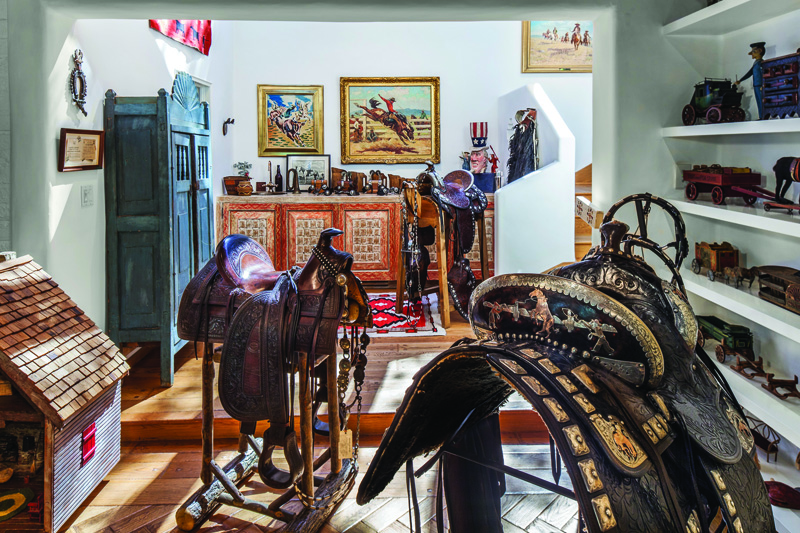
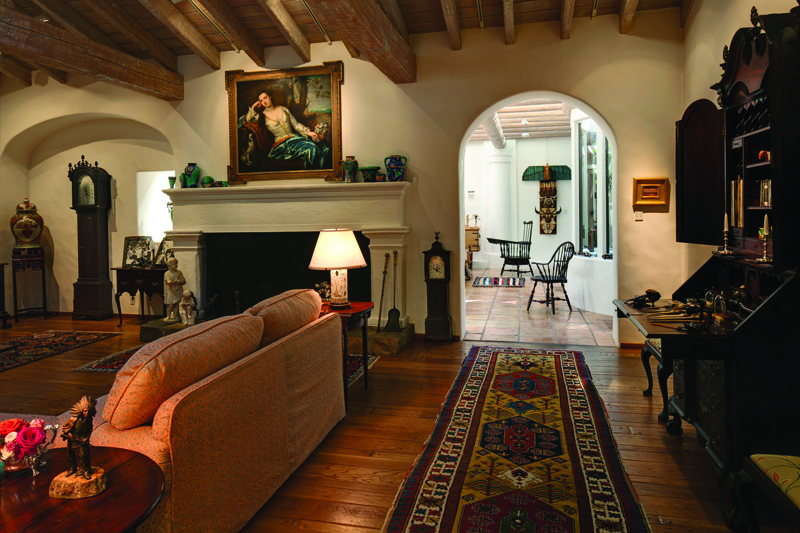
Russell Carrell (1916-1998) favored kelly green blazers and Bermuda shorts in madras plaid, a dubious combination in a man with less taste. But like Sister Parish, the designer who was his contemporary, the Connecticut antiques dealer had a knack for creating cozy interiors whose color-splashed charm depended on their slightly haphazard arrangement of country furniture and folk art.


Carrell, who often signed his displays with canary-yellow Staffordshire, launched the first flea market in the United States in 1958 and managed New York’s Winter Antiques Show from 1960 to 1987. Having perfected the charity-show formula, he ran upmarket events from coast to coast. His presentations articulated a new American style, one urging a relaxed approach to living with antiques.

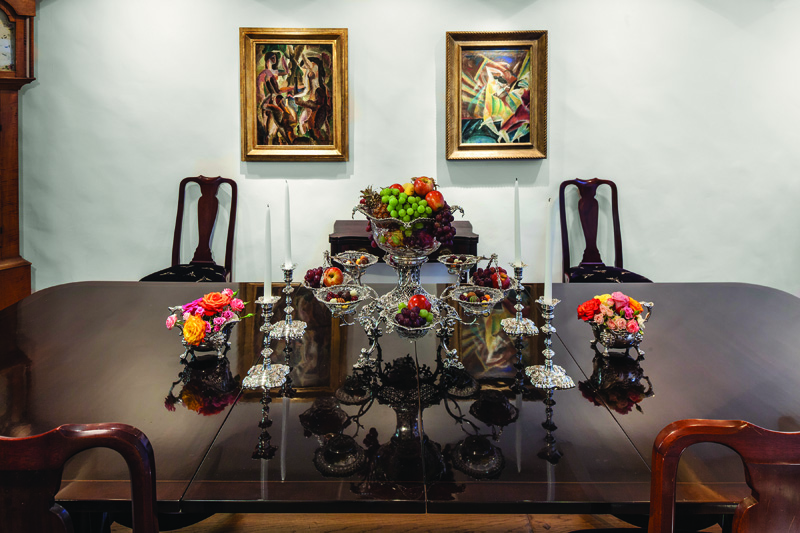
The California couple whose collection appears here were young when Carrell was in his prime. The husband’s connection to the promoter was through his mother, a Woodstock, Illinois, antiques dealer who loved what Carrell loved: quirky painted furniture, simple domestic articles worn smooth by use, humble objects endowed with nobility by makers of small means and great imagination. An exhibitor at Carrell’s Lake Forest Antiques Show in Illinois, she passed to her son a passion for antiques along with an appreciation for dealers and collectors-their communal but competitive nature and their annual peregrinations to gatherings in places such as New York and New Hampshire. Boyhood vacations in the Ford wagon were busman’s holidays, with stops to see the Samahas in Ohio, the Kindigs in Pennsylvania, and Liverant and Walton in Connecticut.

After earning his law degree at Stanford, the husband, a rangy man with a direct, personable manner, took up practice in Los Angeles, where he met his future wife, a gracious brunette active in a host of charities. A native Californian who remembers an Orange County of endless groves, she grew up surrounded by fine European art and antiques. When the couple married and settled in Los Feliz, each brought along pieces steeped in family memories.

Carrell, who often signed his displays with canary-yellow Staffordshire, launched the first flea market in the United States in 1958 and managed New York’s Winter Antiques Show from 1960 to 1987. Having perfected the charity-show formula, he ran upmarket events from coast to coast. His presentations articulated a new American style, one urging a relaxed approach to living with antiques.

The California couple whose collection appears here were young when Carrell was in his prime. The husband’s connection to the promoter was through his mother, a Woodstock, Illinois, antiques dealer who loved what Carrell loved: quirky painted furniture, simple domestic articles worn smooth by use, humble objects endowed with nobility by makers of small means and great imagination. An exhibitor at Carrell’s Lake Forest Antiques Show in Illinois, she passed to her son a passion for antiques along with an appreciation for dealers and collectors-their communal but competitive nature and their annual peregrinations to gatherings in places such as New York and New Hampshire. Boyhood vacations in the Ford wagon were busman’s holidays, with stops to see the Samahas in Ohio, the Kindigs in Pennsylvania, and the Liverants and John Walton in Connecticut.

After earning his law degree at Stanford, the husband, a rangy man with a direct, personable manner, took up practice in Los Angeles, where he met his future wife, a gracious brunette active in a host of charities. A native Californian who remembers an Orange County of endless groves, she grew up surrounded by fine European art and antiques. When the couple married and settled in Los Feliz, each brought along pieces steeped in family memories.

Their move to a new neighborhood twenty-five years ago set the stage for what would come. In a lush hollow in one of the city’s most desirable canyons, they happened on a vintage house with old-time charm and a dusting of Hollywood glamour. Commissioned in 1933 by an attorney and his wife, the residence was designed by Gerard Colcord, an École des Beaux-Arts-trained architect who worked out of a small office in Beverly Hills for more than four decades. Colcord’s conservative clientele clamored for “country colonials,” as he called them, or fanciful Tudor, country French, and Hollywood regency designs. Harrison Ford, Zubin Mehta, and Bob Newhart are latter-day enthusiasts of the architect. The couple acquired their Colcord house from a Grammy Award-winning producer and his then-wife, a star of a hit television series of the late 1960s and early 1970s.
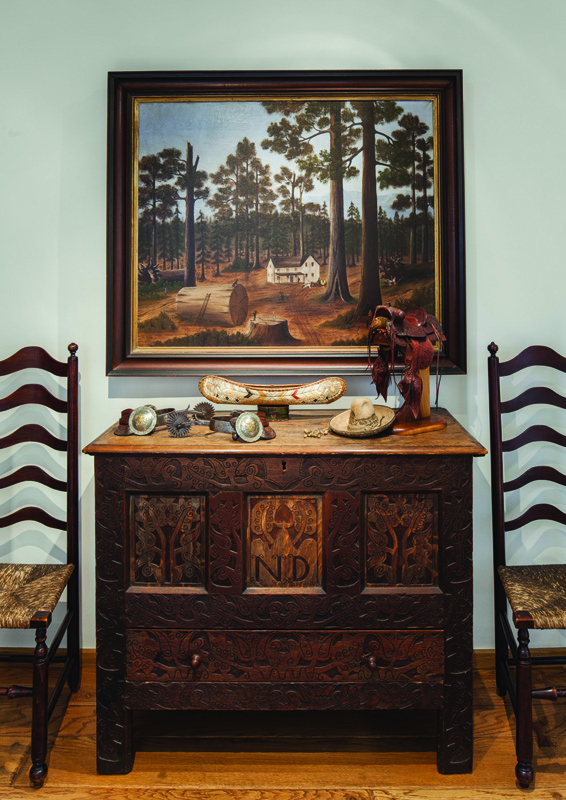
Low and rambling with a tile roof, the brick and stucco-clad Spanish colonial style residence is a series of intimately scaled rooms with whitewashed walls, hewn beams, and graceful nichos for displaying sculpture and ceramics. It has been altered and expanded over the years with an eye toward preserving its original character. There is a sunny gallery where the loggia once stood; the old garage and maids’ rooms are now guest quarters. Newly carved and painted Santa Fe-style mantels, doors, and cabinetry, and colorfully tiled bathrooms evince the couple’s flair for design. The terraced property climbs to a pool house whose vaulted ceiling shelters a spirited blend of American folk art and formal furniture (Fig. 18).
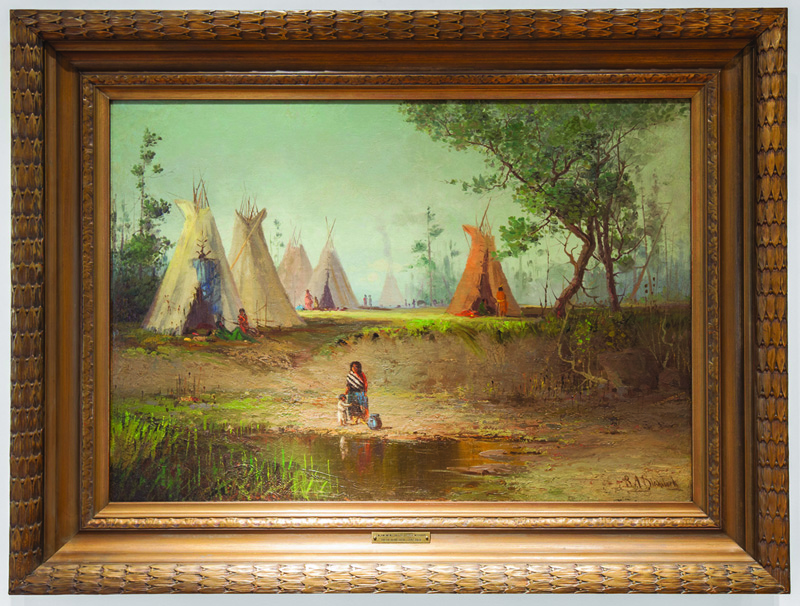
Not limited to one period or style, the couple has gathered choice but disparate objects that, imaginatively grouped, define their aesthetic stance and philosophical approach to collecting. “We love color and design. That’s what got us started,” the wife says. “Collecting has become a major pastime for us. Beyond the objects, it’s the stories, experiences, and the people. Each piece tells a story,” the husband explains.
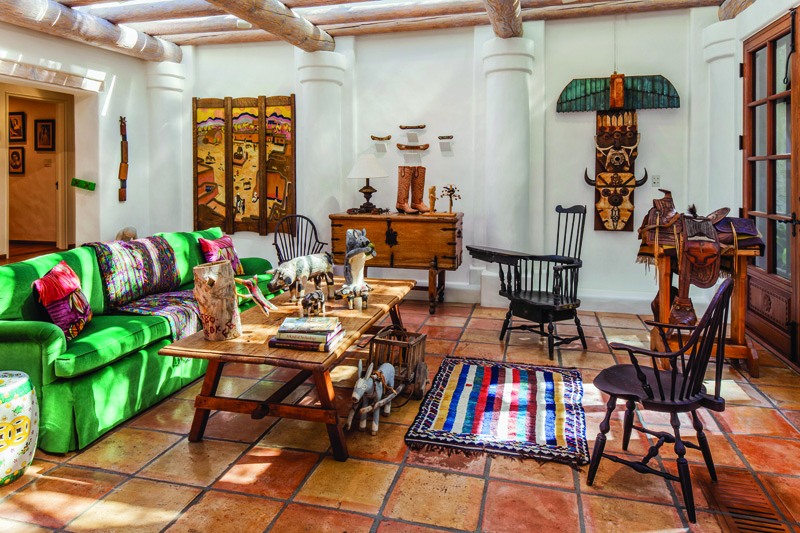
Subtly autobiographical, the collection is an idiosyncratic blend of East, West, and Midwest stretching from pilgrim New England to cinematic California. “I bought my first antique, a drop-leaf table, at a country auction when I was fifteen,” the husband says. In the den, a Pennsylvania step-back cupboard in blue and yellow paint traveled from his family’s Illinois farm. Encampment on the Upper Missouri, an oil by Ralph Blakelock (Fig. 9), and two watercolor farm scenes by the Wisconsin folk artist Paul A. Seifert (see Fig. 10) are further references to the heartland.
The husband’s first love is eighteenth- and early nineteenth-century New England furniture, especially pieces from Massachusetts and Connecticut. “Its simplicity appeals to me,” says the collector, who buys widely but works closely with a New York-based furniture conservator who reviews his choices. One of the earliest pieces of furniture in his collection is a one-drawer Hadley chest, made of oak and pine in Hampshire County, Massachusetts between 1715 and 1725 (see Fig. 1). Sinuously carved scrolls, tulips, and leaves enclose the initials “ND” on the iconic piece, one of roughly 125 examples of the form known. Possibly made for a member of the Dickenson family, the chest was consigned to auction by the estate of Barbara Belding Clapp.
Another Connecticut River valley piece-with ties to Wethersfield, Connecticut-came from Nadeau’s Auction Gallery in Windsor, Connecticut (see Fig. 17). Dating to about 1770, the cherry high chest of drawers with a scrolled bonnet top is from a group of pieces published by Thomas P. and Alice K. Kugelman and Robert Lionetti in Connecticut Valley Furniture: Eliphalet Chapin and His Contemporaries, 1750-1800.

A cherry tall-case clock of about 1765-1790 with a silvered dial and works signed by John Avery of Preston, Connecticut, surfaced at the Winter Antiques Show in 2006, where the couple purchased it from Nathan Liverant and Son (see Fig. 7). Another prize of the collection is a serpentine-front chest made around 1780 that is attributed to Thomas Needham Jr. (1755-1821) of Salem, Massachusetts. Surviving Salem chests of this kind with blocked ends are among the rarest of American eighteenth-century furniture forms.
“My husband brought me into the antiques world. It’s something that we have enjoyed together. We’ve had fun and have met wonderful people,” says the wife, whose past leadership role in the Los Angeles Antique Show exposed her to a range of specialties and a host of experts, many of whom have spent time in the couple’s home. Her eclectic interests and appraising eye have contributed to an imaginative series of collections within collections. In London the couple met Richard Green and Des Jones, authors of The Rich Designs of Clarice Cliff, a chance encounter that led her to collect Cliff’s modernist English pottery of the 1920s and 1930s (see Fig. 7).
Working with Philadelphia dealer Elle Shushan, the wife has assembled a significant collection of American portrait miniatures, including eight watercolor likenesses by the itinerant folk artist James Sanford Ellsworth (see Fig. 8). “Isn’t this wonderful?,” she says, producing a small solemn image of Theodore Crawford, a Guilford, Connecticut, man painted in 1851 in his blue and white striped waistcoat.
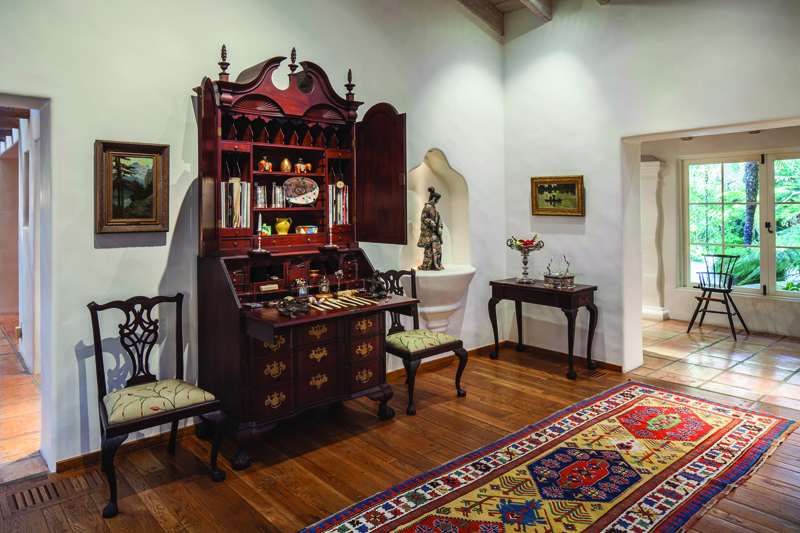
Named a director of the Bank of California, where he was the youngest and, later, the longest serving member of the board, the husband revels in the history of his adopted state, a tale retold in the couple’s collection of California paintings, spurs, and saddles. “The bank’s history is the history of the West itself. It was a product of the Gold Rush,” he explains.
Linda Kohn Sherwood and her husband, Joseph Sherwood, founders of the Los Angeles-based firm High Noon Western Americana and the annual January auction and show of the same name in Arizona, recall their first sale to the husband in the 1980s, a pair of twentieth-century spurs embellished with silver hearts. Since then, he has acquired about fifteen antique saddles and dozens of spurs distinguished by their ornate tooling, elaborate metal mounts, and distinguished provenances.
“It’s a world-class collection,” says Joseph Sherwood. Three saddles are by the preeminent nineteenth-century San Francisco saddlery Main and Winchester, which flourished during the Gold Rush. Another is by Marcus Stern (d. 1905), who began making saddles in San Jose, California, in 1854. The collection’s oldest spurs-decorated lavishly with silver filigree, silver thread, and cast and applied silver conchos-are Mexican and date to around 1860. Shanks fashioned as toucan birds hold in place their sharp-toothed wheels, called rowels.
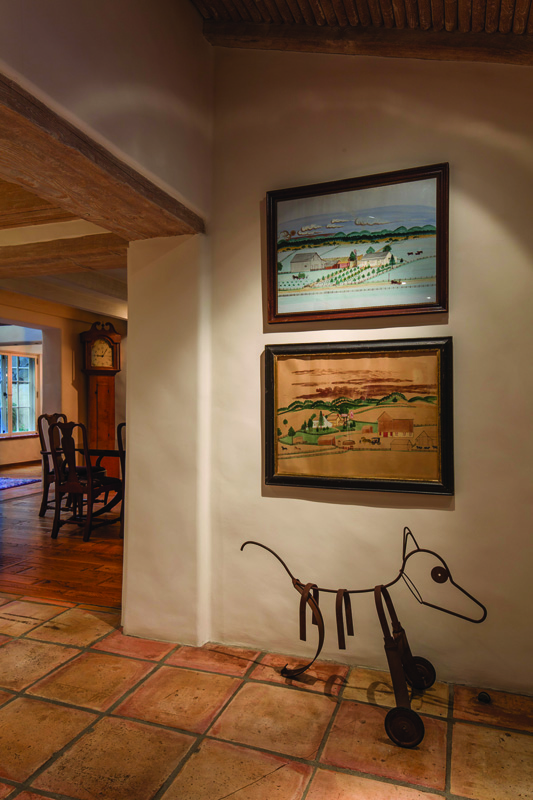
Saddles have special meaning in Southern California, where film stars and other early twentieth-century luminaries owned saddles made for show. The foremost maker of dress and parade saddles, Swedish-born Edward H. Bohlin, opened his first shop in Cody, Wyoming, before moving to Hollywood. Encouraged by the movie cowboy Tom Mix (1880-1940), Bohlin became the “saddle maker to the stars,” with a clientele ranging from Buck Jones and Roy Rogers to William Randolph Hearst and Ronald Reagan. Last year, the collectors, who actively support the Autry National Center of the American West, acquired one of Bohlin’s most celebrated saddles and a matching set of spurs, custom-made in the late 1920s for the Orange County horsewoman Mabel Yorba, a native Nebraskan who married the scion of a California land-grant family (see Figs. 4, 14). His self-assured patron in mind, the craftsman decorated the saddle with gold and sterling silver mounts depicting a woman lassoing a bucking bronco (see Fig. 14a). Her hapless cowboy companion manages to ensnare only a cactus tree. “Hundreds of people have told us about meeting Bohlin, who inspired reverence with his perfectionism and showmanship. His saddles were always expensive. In the early 1950s, a Bohlin saddle could cost as much as $7,500, about the price of a house in west Los Angeles at the time,” Sherwood says.
Late in their lives, the husband’s normally cautious parents approached him with a business proposition: buy the collection and inventory of the late Peggy Krupp, a Barrington, Illinois, antiques dealer who was a family friend. The husband obliged. “We sold a house and barn full of antiques, cash and carry, and sent the rest to auction. I kept a dozen things, including an early eighteenth-century Queen Anne high chest of drawers, probably from eastern Connecticut or Long Island. It remains one of my favorite pieces,” he says, noting the joy that the venture gave his parents and the satisfaction he still feels each morning as he sits at his breakfast table, admiring the chest from across the room.

Having inherited the collecting bug, the couple has passed it to their son and daughter. The children’s first passion was for vintage war posters. Now, with houses of their own, they embrace their parents’ love of Americana. Collecting is a family affair. Mother and son added folk art to the beach house where the generations gather, and last August father treated daughter to a set of six Pennsylvania plank-seat Windsor side chairs painted in vivid azure blue at Northeast Auctions.
Many dealers and collectors share a deep concern that history, or at least our memory of it, is endangered, and that by forgetting our past we cramp our vision of the future. But in one California family, at least, antiques are keeping the everyday past alive while serving as a generational bridge to tomorrow.
Small at first glance, the canary-yellow jug holds more than you might imagine.
– Laura Beach
